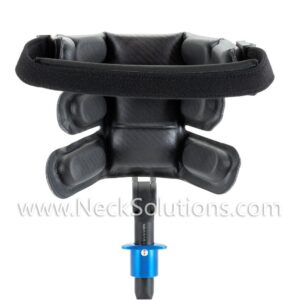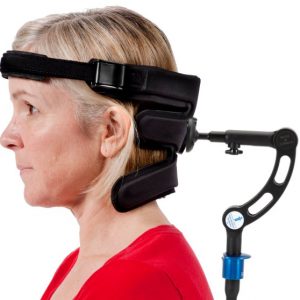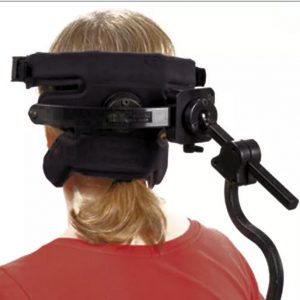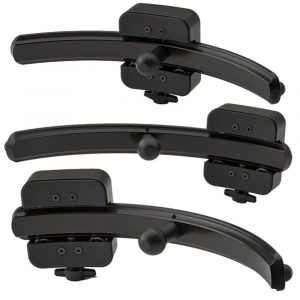Our Wheelchair Headrests Offer Comfort And Ergonomic Options With Multiple Adjustment Capabilities
These headrests are versatile and can attach to a solid or cloth back wheelchair for superior head and neck support. The wheelchair headrests offer basic neck support to complete head control for conditions like ALS and other condition affecting head posture like head drop syndrome.
Wheelchair headrests are sold separately from the hardware to attach the headrest to the wheelchair or in combination with hardware. We do not trial any wheelchair equipment. If you need a trial, please contact us.
Savant & Apex Wheelchair Headrests
Quality, functionality and unique design make these the headrests of choice. From basic positioning with multiple option, the Apex offers both superior comfort and support. The Savant specializes in head control. Using a special headband and extension arms that are adjustable, conditions requiring the headrest to hold the head up and/or in a specific position is achieved.
Axion Interface
The Axion is not a headrest, but an interface that goes between the headrest and hardware. It permits rotation in a horizontal plane or can be fixed at any degree of rotation to compensate for postural instability and precise adjustments. It can be used with the Savant or other headrest/hardware combinations.
Soft Back Wheelchair Headrests Solution
The wheelchair headrest adapter provides a great solution for those who have typical wheelchairs with regular cloth or vinyl backs. Instead of purchasing a new chair, the adapter allows mounting of a headrest easy with your choice of hardware. Using the canes of the chair (vertical metal tubes), a stable mounting solution with a Clinical Headrest Mounting Adapter is available to mount a headrest for comfort, or to use our popular Savant headrest for dropped head syndrome conditions.
Wheelchair Headrests & Hardware Configurations
From basic to complex, we have the headrest hardware that can match the needs of the patients. Very high quality means they are both attractive and durable. Options for flip-down makes it easy for transportation and storage. Multi-axis allows for precise adjustments. Extended multi-axis permits patients with high degrees of flexion to easily use any headrest. The spring loaded option permits shock stabilization for transport or other conditions.
With these options, you can easily match the headrest/hardware set up that gives you the options you need for the best support, functionality, comfort and safety. There is an adapter to attach any of the systems to a cloth or vinyl back wheelchair
Reducing backward motion of the neck and head can minimize whiplash neck injury during a rear end collision. Properly designed headrests should provide restriction of this backward neck and head motion, therefore, reducing the extent of injuries to the neck. Wheelchair headrests are generally not made to offer restraint of the head during a back impact and, consequently, might not supply complete neck and head protection. Nevertheless, using the concepts associated with occupant safety as well as understanding the biomechanics regarding injuries, the probabilities pertaining to neck injuries may be reduced
Many wheelchair users are unable to transfer to a vehicle seat and the wheelchair serves as a means of both mobility and postural support during daily activities and as a seating support in a vehicle. Headrest devices support and align the head and neck in a stable and functional position. An integral part of the seating system, headrests are typically utilized throughout the day and, therefore, remain on the wheelchair while the user rides in or drives a vehicle.
When front head support is necessary, soft collars that are not attached to the wheelchair are preferred over stiff collars or forehead strap systems that are anchored to the wheelchair. Preliminary data on neck collars tested with child restraint systems show an increase in neck tension with stiff collars. The increased neck tension resulted from the bottom of the chin pivoting on the top of a stiff neck collar and stretching the neck during a frontal crash.
Since stiffer neck collars produced higher neck tensions, it is recommended to use the softest and lightest neck collar that can perform the needed function.
Forehead straps might result in neck hyperextension during a front collision. Avoiding the head from moving forward yet still permitting forward movements with the body because of stretching of the belt or perhaps loose belts or supports could lead to neck extension injury. In the event that these kinds of devices are essential when traveling, they need to discharge at the smallest force possible even though offering useful posture support. An additional possible problem using forehead straps is they can become misplaced plus slide across and down the neck, causing injury.
Important Note: It is always recommended to have a professional for measuring and mounting wheelchair headrest equipment. Products are not transport tested or approved. Use is at the user/caregiver’s own risk and should be supervised at all times. If you need assistance or have questions regarding the wheelchair headrests or hardware, please feel free to contact us and we will be glad to assist.

A 2020 study in the Proceedings of the Institution of Mechanical Engineers indicates based on deformation and recovery characteristics, special manufacturing is an appropriate method to produce a highly customized, lighter weight, and safe head supports for wheelchair users. We are proud to be a certified distributor for one of the most highly advanced manufacturers on the market specializing in support for head posture.
A 2021 study in Pain and Therapy indicates wheelchair users are at a high risk of experiencing musculoskeletal pain. The most common was shoulder pain which was almost 6 times higher than non-wheelchair users. Other pain syndromes included neck, elbow, wrist, hand and low back pain. Older age and increased duration of use were significant determinants of pain. The authors conclude, “Optimal adjustment of seating position may prevent pain, and is important to be taken into consideration”. A good wheelchair seat cushion can help with comfort.
A 2022 study in the International Journal of Environmental Research and Public Health found a combination of 20 degrees reclining and 10 degrees tilt angles can decrease normal and shear force in the gluteal region to help wheelchair dependent individuals avoid pressure injuries.








